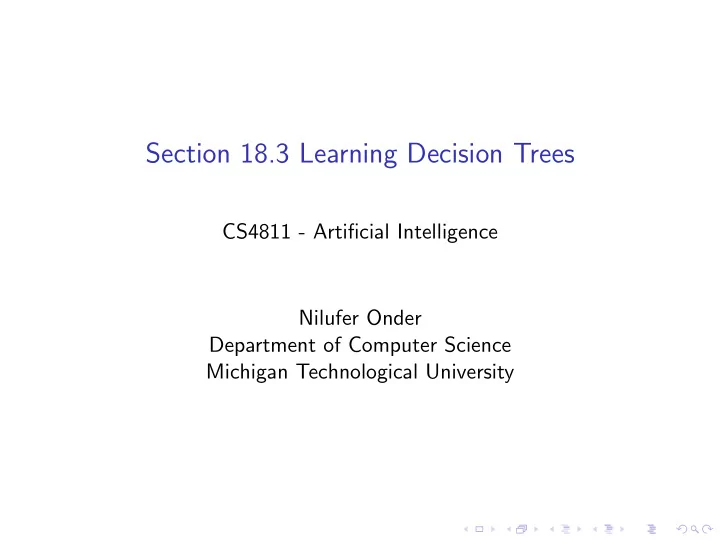

Section 18.3 Learning Decision Trees CS4811 - Artificial Intelligence Nilufer Onder Department of Computer Science Michigan Technological University
Outline Attribute-based representations Decision tree learning as a search problem A greedy algorithm
Decision trees ◮ A decision tree allows a classification of an object by testing its values for certain properties. ◮ An example is the 20 questions game . A player asks questions to an answerer and tries to guess the object that the answerer chose at the beginning of the game. ◮ The objective of decision tree learning is to learn a tree of questions which determines class membership at the leaf of each branch. ◮ Check out an online example at http://www.aiinc.ca/demos/whale.shtml
Possible decision tree
Possible decision tree (cont’d)
What might the original data look like?
The search problem This is an attribute-based representation where examples are described by attribute values (Boolean, discrete, continuous, etc.) Classification of examples is positive (T) or negative (F). Given a table of observable properties, search for a decision tree that ◮ correctly represents the data (for now, assume that the data is noise-free) ◮ is as small as possible What does the search tree look like?
Predicate as a decision tree
The training set
Possible decision tree
Smaller decision tree
Building the decision tree - getting started (1)
Getting started (2)
Getting started (3)
How to compute the probability of error (1)
How to compute the probability of error (2)
Assume it’s A
Assume it’s B
Assume it’s C
Assume it’s D
Assume it’s E
Probability of error for each
Choice of second predicate
Choice of third predicate
The decision tree learning algorithm function Decision-Tree-Learning ( examples, attributes, parent-examples ) returns a tree if examples is empty then return Plurality-Value ( parent-examples ) else if all examples have the same classification then return the classification else if attributes is empty then return Plurality-Value ( examples ) else A ← argmax a ∈ attributes Importance ( a, examples ) tree ← a new decision tree with root test A for each value v k of A do exs ← { e : e ∈ examples and e . A = v k } subtree ← Decision-Tree-Learning ( exs, attributes-A, examples ) add a branch to tree with label ( A = v k ) and subtree subtree return tree
What happens if there is noise in the training set? Consider a very small but inconsistent data set: A classification T T F F F T
Issues in learning decision trees ◮ If data for some attribute is missing and is hard to obtain, it might be possible to extrapolate or use unknown. ◮ If some attributes have continuous values, groupings might be used. ◮ If the data set is too large, one might use bagging to select a sample from the training set. Or, one can use boosting to assign a weight showing importance to each instance. Or, one can divide the sample set into subsets and train on one, and test on others.
How large is the hypothesis space? How many decision trees with n Boolean attributes? = number of Boolean functions = number of distinct truth tables with 2 n rows. = 2 2 n
Using information theory ◮ The “probability of error” is based on a measure of the quantity of information that is contained in the truth value of an observable predicate. ◮ Information answers questions: the more clueless we are about the answer initially, the more information is contained in the answer. ◮ The scale is to use 1 bit to answer a Boolean question with prior < 0 . 5 , 0 . 5 > . ◮ The entropy of the prior is the information in an answer when the prior is < P 1 , . . . , P 2 > : n � H ( < P 1 , . . . , P 2 > ) = − P i log 2 P i i =1
Summary ◮ Decision tree learning is a supervised learning paradigm. ◮ The hypothesis is a decision tree. ◮ The greedy algorithm uses information gain to decide which attribute should be placed at each node of the tree. ◮ Due to the greedy approach, the decision tree might not be optimal but the algorithm is fast. ◮ If the data set is complete and not noisy, then the learned decision tree will be accurate.
Sources for the slides ◮ AIMA textbook (3 rd edition) ◮ AIMA slides: http://aima.cs.berkeley.edu/ ◮ Jean-Claude Latombe’s CS121 slides http://robotics.stanford.edu/ latombe/cs121 (Accessed prior to 2009) ◮ Wikipedia article for Twenty Questions http://en.wikipedia.org/wiki/Twenty Questions (Accessed in March 2012)
Recommend
More recommend